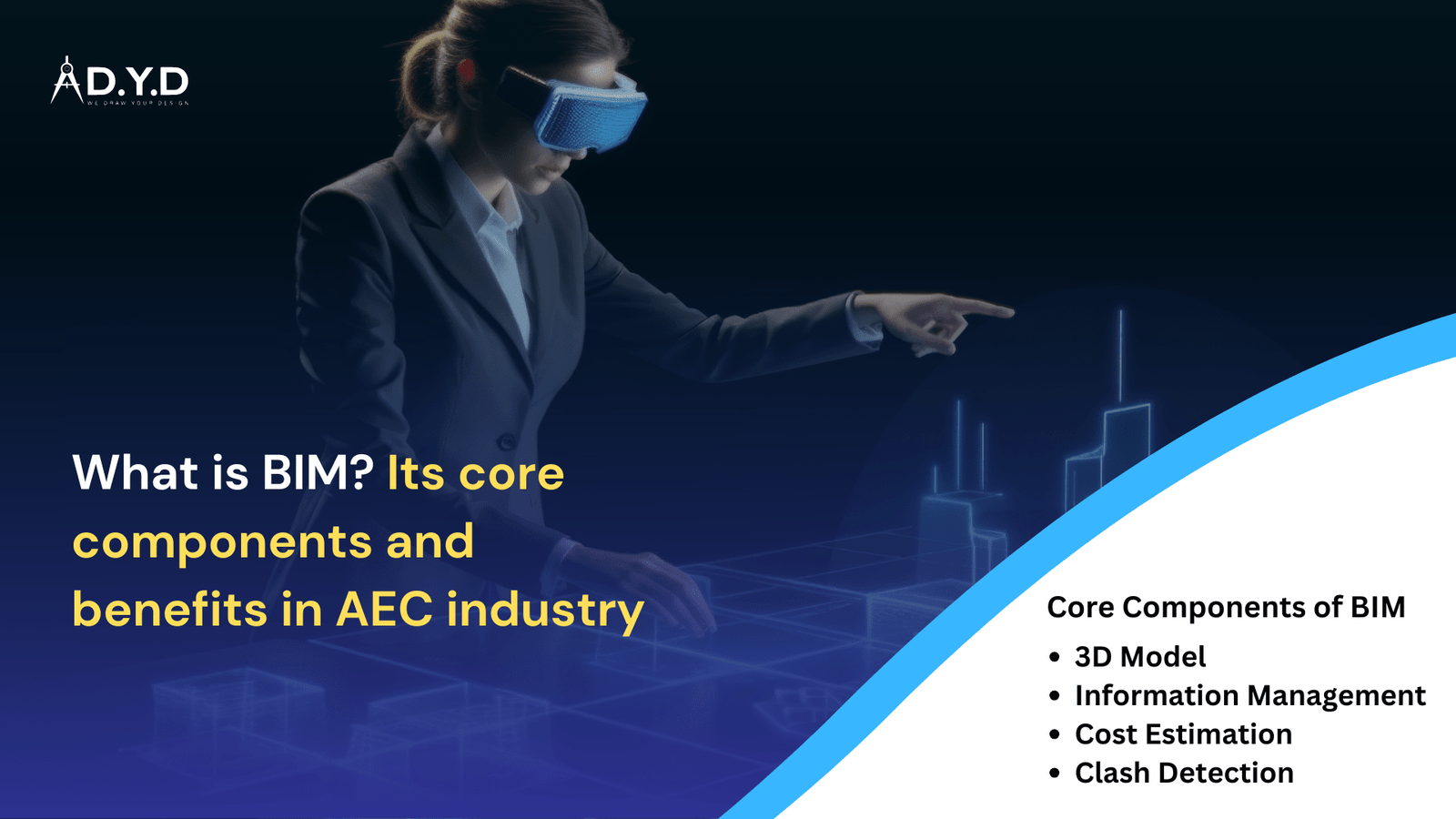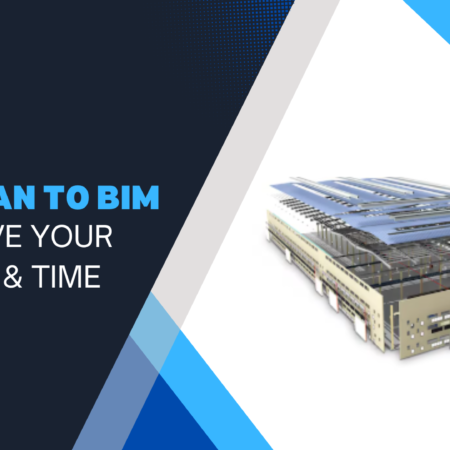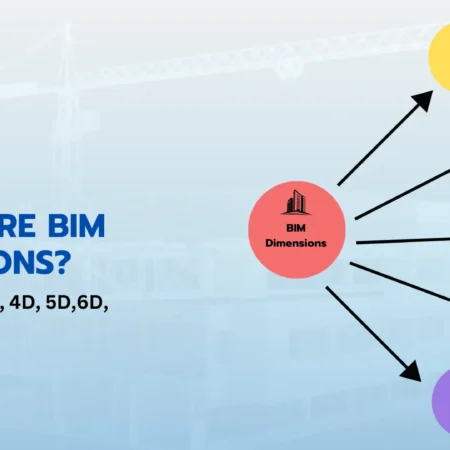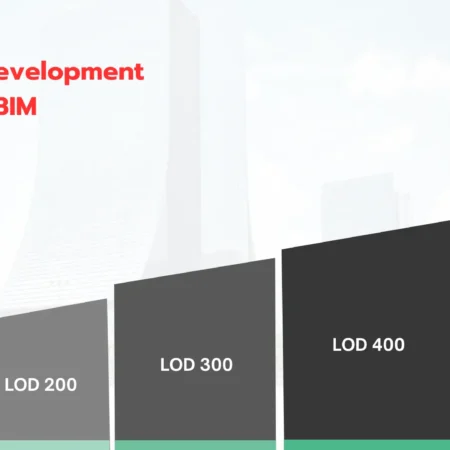
What is Building Information Modeling (BIM)?
BIM stands for Building Information Modeling which is a virtual model of the architectural, structural and MEP design of a building. It has revolutionized AEC industries by bringing in new modes of working that are efficient, integrated and accurate for designing, constructing and managing buildings. It is an organic process that involves generation and control of information about a building from its conception to its finality. The information is stored in a spatial model used to represent and define a building and its facilities; its construction, design, systems, and equipment, right down to its use and management.
BIM is more than traditional blueprints or 2D drawings. It brings data into the design process, so architects, engineers, and contractors can work on up-to-date and accurate information. It enables collaborative work, improves project results, and minimizes errors in the construction process by allowing everyone to access and change the model in real time.
History of BIM:
The concept of BIM has evolved drastically. The term ‘BIM’ wasn’t even in use until the late 1990s, but the beginnings of the term can be traced back to early computer-aided design (CAD) systems in the 1960s. These tools initially were used for drafting and design but could not integrate detailed data and simulate the performance of buildings in the real world.
Early CAD programs were getting underway to digitize architecture and design in the 1970s and 1980s. But it wasn’t until the 1990s that the BIM technology we know today began to appear. With true 3D modeling combined with built-in information about material, structural components, and energy analysis, software like Autodesk Revit and ArchiCAD provided a more realistic, more actionable digital representation of a building.
How Does Building Information Modeling Work?
The 3D model of a building in BIM is an integrated model that is detailed. The components of building parts, such as walls, windows, doors, electrical systems, plumbing, and, in short, all components needed to build a building, are taken into account in this model. In contrast to traditional design methods, which split up 2D drawings by discipline (architecture, structure, MEP), all disciplines come together in a single unified model.
The tools for visualization, simulation, and analysis are provided by BIM software. The model can also be used by designers to visualize the building in a 3D space, simulate how different systems interact, and determine what the potential issues are before a single piece of the building is ever placed. The model can be updated in real time, thus all stakeholders can rely on the latest information. Coordinated by this real-time collaboration, errors are reduced, coordination is improved, and building processes are faster and more accurate.
Benefits of Building Information Modeling:
BIM offers numerous advantages for professionals in the AEC industry. Here are some key benefits:
Enhanced Collaboration and Communication
BIM enables all parties—architects, engineers, contractors, and clients—to work on one shared digital model that improves collaboration and communication. Updates are real-time so that everyone is on the same page, removing confusion and time delays from outdated information.
Cost and Time Savings
BIM creates a clear and accurate digital representation of the building, which reduces the risk of errors and changes in design during construction time. It results in a great cost saving as well as having projects completed on time. In addition, BIM also helps project teams schedule precisely as well as allocate resources more efficiently.
Increased Accuracy and Reduced Risk
Features of BIM’s 3D modeling and clash detection, for example, help identify potential problems, such as conflicts between mechanical, electrical, and plumbing systems, before the first piece of equipment is set in place. BIM does this by catching these problems early before the design phase, reducing both costly rework and delays during construction.
Sustainability and Energy Efficiency
Advanced energy analysis and modeling is enabled with BIM to allow architects to create more sustainable, energy-efficient buildings. BIM simulates how a building will behave in certain environmental conditions to ensure energy consumption and resource usage are minimized.
Core Components of BIM:
BIM encompasses several key components that make it a powerful tool for architecture design and construction. Let’s take a closer look at some of these elements:
3D Model
BIM is supported by the 3D model, a digital representation of a building. Not only does it show physical structure, but it also includes data for materials, dimensions, and performance characteristics. Using this comprehensive 3D modeling, architects and engineers can see what it will look like before it’s built, see potential problems, refine plans, and coordinate better among themselves before a single shovel of dirt is turned.
Data and Information Management
BIM data and information management allows all essential information regarding a building project to be stored in a centralized mode. It includes material, component, and system specifications. BIM connects each object in the 3D model to detailed data that improves decision-making, decreases errors, and ensures the project team works from accurate, up-to-date information throughout the process.
Cost Estimation
The linking of the 3D model to detailed quantities, materials, and labor costs makes BIM useful in estimating accurate costs. With the data generated by the model, project teams are able to make very precise cost projections and track the changes throughout the project. This dynamic cost estimation allows one to control budgets, avoid cost overruns, and identify cost-saving opportunities by suggesting alternative materials or methods.
Clash Detection and Simulation
Probably the most valuable feature of BIM is clash detection. It automatically identifies the potential conflicts between different building systems (structural elements interfering with plumbing or electrical systems). BIM helps avoid costly delays in construction by solving these issues early in the design process.
The Future of Building Information Modeling:
The future of BIM is incredibly promising. As technology continues to advance, BIM will become even more powerful and accessible. Here are some trends to watch for:
Integration with Artificial Intelligence (AI)
BIM looks to machine learning and AI for making the most of these advances, automating the boring stuff so designers can focus on innovation, and predicting project outcomes with greater accuracy. Such a reduction in design time would significantly shorten and improve decision-making.
Virtual Reality (VR) and Augmented Reality (AR)
BIM is already hybridizing with VR and AR, and as they begin to integrate, clients and project teams can start walking through digital models in immersive experiences. These technologies give a more tangible understanding of the design and are able to identify problems that are not visible on a traditional screen.
Increased Adoption of Cloud-Based BIM
The growth in cloud-based BIM platforms will allow teams to collaborate on projects no matter where they are located. Cloud platforms also bring improvements to data storage, security, and version control so that everybody works with the most up-to-date information.
Conclusion:
By continuing to integrate, collaborate, and be more accurate, Building Information Modeling (BIM) is transforming the architecture, engineering, and construction (AEC) industries through building design and construction. BIM is fast becoming the standard in modern construction projects, offering its capability to streamline workflows, reduce errors, and optimize the use of resources.
BIM will continue to evolve as the technology progresses, extending its benefits to the architecture design and construction process more and more, making it a must for anyone in the architecture design or construction field. If this is your first time learning about BIM or you’re trying to expand your knowledge of the technology, now is the best time to embrace the technology.
FAQs:
What is Building Information Modeling (BIM)?
BIM is a digital process used in architecture, engineering, and construction to create and manage a building’s information throughout its lifecycle using 3D models.
Why is BIM important in construction projects?
BIM improves collaboration, reduces errors, enhances project visualization, and streamlines workflows, resulting in cost and time savings.
Is BIM only for large-scale projects?
No, BIM can be used for projects of all sizes, from small residential buildings to large infrastructure projects.
What software is commonly used for BIM?
Popular BIM software includes Autodesk Revit, ArchiCAD, Bentley Systems, and Vectorworks, among others.
Does BIM support sustainable building practices?
Absolutely! BIM allows for energy simulations and material optimization, promoting eco-friendly construction methods.



